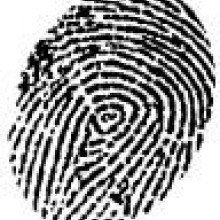This week, Tom Crawford put Helen's question under the magnifying glass to try and find out whether fingerprints really are unique and if so, whether the same applies to toeprints? We put this to Forensic Scientist, Professor Niamh Nic Daeid form Dundee University...
In this episode

Why are fingerprints unique?
This week, Tom Crawford put Helen's question under the magnifying glass to try and find out whether fingerprints really are unique and if so, whether the same applies to toeprints? Tom - The movies say that if your fingerprints are found at the scene of the crime, you're guilty. But does this notion hold up in the real world. Forensic scientist Professor Niamh Nic Daeid, put me through my paces at our very own virtual crime scene where, would you believe it, the murderer has left his fingerprints on the candlestick in the dining room.
I guess the first thing we need to know is whether fingerprints are actually unique?
Niamh - In forensic science, we're actually moving away from the notion that fingerprints can be considered as unique. And instead, we talk about the comparison between fingerprints and finger marks. Fingerprints are the records that are taken directly from a person's finger by law enforcement. Finger marks are what we regard from crime scenes.
Tom - I see. So, what I've found is actually a finger mark, not a fingerprint.
Niamh - Yes, that's exactly right. To find evidence that our culprit may have been at the scene, we would need to compare the finger mark taken from the crime scene with a database of fingerprints that contain the fingerprints of our culprit.
Tom - What tell-tale signs are we looking for?
Niamh - Well, there are a range of characteristic patterns, which are called friction ridge patterns, in a fingerprint, which can be identified and used to compare fingerprints with finger marks. The most overarching features are called whirls, loops, and arches. Fingerprint examiners will also look for other features for example, where these ridges may divide.
Tom - Okay. That certainly seems like a lot of variation to be packed into a fingertip. We've had a question from Steven on Facebook who wants to know whether the same applies to toe prints.
Niamh - Yes. There are also ridge patterns on the palms of your hand and on your toes.
Tom - So, criminals had better make sure to wear shoes as well as gloves to avoid being caught. But why do we have toe and finger marks in the first place? Listener Akhilesh thought it was due to the different genetic origins of each individual while Teo thought it might be influenced by the place in which we are born or perhaps even the chemical makeup of the soil. David said fingerprints are unique simply so that we can use our iPhones.
Niamh - Well, fingerprints are developed in the womb. They begin to develop about the 10th week of pregnancy and are largely complete by around the end of the 4th month. The print is determined by the relationship between the epidermis, which is the outer skin layer, and the underlying layer of skin called the dermis. It's just thought to be influenced by factors such as blood pressure, the oxygen levels in the blood, both maternal and foetal, the position adopted in the womb by the foetus, the touching of fingers onto the sac and amniotic fluid, nutrition of the mother, hormone levels.
Tom - It's a long list then.
Niamh - It certainly is. What it does mean though is that fingerprints are different on every finger of your hand, they're different between your hands, and that fingerprints of identical twins are different from each other.
Tom - So, identical twins aren't really identical?
Niamh - Yes, that's right.
Tom - There you have it, Helen. Thanks for helping to solve this mystery Niamh. I'll see if I can track down our suspect.
Next time, we're journeying into John's question.
John - What is the most expensive element in the world?
- Previous Just give me a second...
- Next Methanol: Chemistry in its element










Comments
Add a comment